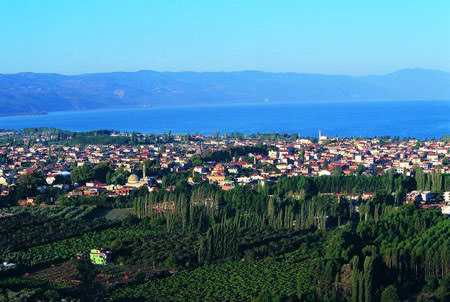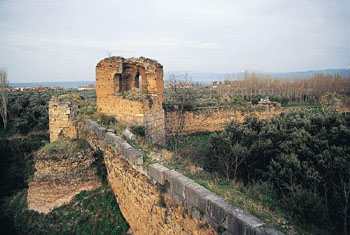ÝZNÝK

The city of Ýznik is surrounded by Roman walls 4427 metres in length. Visitors from
the north enter the city through Istanbul Gate, above whose triple arch masks of a man and
a woman look as if they belong here, although in fact they were moved here from another
building in the city at a later date. The Yeniţehir and Lefke gates are also
triple-arched. The fourth göl (Lake) Gate is no longer standing. Like other
northerners we entered Ýznik through Istanbul Gate. According to Strabo,
the famous geographer of the ancient world, Ýznik was founded in 316 BC by Antigonus, one
of Alexander the Great’s generals, who named it Antigoneia.
Lysimachos, another of Alexander’s generals, later took the city and renamed it after
his wife Nicea. Following his death, the city was taken by the Bithynians, Romans, Goths
and once again the Romans. When the Emperor Constantine was converted to Christianity in
313 AD, Ýznik became an important religious centre. The Nicene Creed was adopted here at
the First Ecumenical Council held in 325 in the Senatus Palace, which today lies beneath
the waters of the lake.
 Ýznik, a city and district in the province
of Bursa, has many historic monuments. These include a 15.5 metre high obelisk-like
tombstone known as beţtaţ (the Five Stones) in the village of Elbeyli erected
in the 2nd century to mark the grave of Cassius Philiscus. Ýznik, a city and district in the province
of Bursa, has many historic monuments. These include a 15.5 metre high obelisk-like
tombstone known as beţtaţ (the Five Stones) in the village of Elbeyli erected
in the 2nd century to mark the grave of Cassius Philiscus.
Again near Elbeyli is an underground tomb or hypogeum containing unusually fine frescos
that make it the most important tomb of its kind in Turkey. Excavations of the Roman
theatre in the city centre are still continuing. When the Roman Empire split in two in
395, leaving Ýznik in the Eastern Roman Empire, new churches and water channels were
constructed in the city. The city continued to play an important religious role, and in
787 the Seventh Ecumenical Council was held in the 4th century basilica of Haghia Sophia.
The main outcome of the counc’sea deliberations was the rejection of iconoclasm, so
permitting reverence of icons.
The ceiling of Haghia Sophia, like those of so many other churches in Ýznik, has
collapsed, and the mosaic pavements have been covered for protection. The ancient water
lines remained in use until the 1970s, but today are overgrown by trees and bushes.Ýznik
has always been an important halting place on the road leading eastwards into Anatolia
from Istanbul, and at various times has served as capital city to three different states.
In 1075 the Seljuk commander Kutalmýţođlu Süleyman Ţah I changed the name Nicea to
Ýznik and pronounced the city to be capital of the state he had founded, which survived
only 22 years. When the crusaders invaded Istanbul in 1204, the Byzantine imperial family
fled the city, and in 1206 Theodor Laskaris proclaimed himself emperor and Ýznik his
capital.
Ýznik enjoyed this privileged position for 55 years until the Byzantines were
re-established in Istanbul. In 1331 Ýznik became part of the burgeoning Ottoman Empire,
and for four years served as its capital.On the northern edge of the city, inside the
walls, an extraordinary hollow plane tree survives in defiance of time despite a cavity as
large as a room in its trunk. Like this venerable plane tree, some of the Ottoman
buildings in and around Ýznik are still standing, although most are in urgent need of
attention.
One of them is Yeţil Cami (Green Mosque), the oldest instance of Ýznik
tiling decoration on an Ottoman building, dating from 1398. It is named after the
predominantly green tiles which adorn the minaret. Hacý Özbek Mosque, dated 1333, is the
earliest known Ottoman mosque. Nilüfer Hatun Imaret, a hospice or public kitchen dating
from 1338, has housed the city’s museum since 1960. The museum is filled with works
which reflect Ýznik’s splendid history, and more are constantly arriving. For example,
a beautiful Late Hellenistic period sarcophagus in the museum grounds was brought here
after being confiscated in 1999 from smugglers attempting to take it out of the country.
With its baths, mausoleums, medreses, and imarets, Ýznik may justly be described as an
openair museum.
Yet over and above so many claims to fame, Ýznik is best known for its tiles and ceramics, production of which reached its highest
level in the second half of the 16th century. In the 17th century the industry went into
sudden decline, and the last potteries closed in 1716. Despite the intervening centuries
several people have made a determined attempt to revive this distinctive art. Faik
Kýrýmlý and Eţref Erođlu established the first modern pottery here in 1985, followed
by Adil Can Güven in 1987 and Rasih Kocaman in 1988, and have successfully reintroduced
ceramic production to the city.
In 1995 the Ýznik Educational Foundation established the Ýznik Tiles and
Ceramics Research Centre, which has achieved the same high quality as typifies
Ýznik tiles and ceramics of the 16th century. Exhibitions of ceramics produced by the
foundation held abroad have focused worldwide attention on Ýznik ceramics once again.The
district has a largely agricultural economy, based on the fertile soil of Ýznik Plain.
Whether the grapes known as izari recorded by the renowned 14th century Arab
traveller Ibn Battuta, who said he had seen them growing nowhere else, is
still grown here I have no idea, but viticulture is still widespread in the area. Large
quantities of olives, tomatoes and peaches are also grown here, and many other kinds of
fruit and vegetables.Lake Ýznik, the fifth largest in Turkey, contains abundant stocks of
crayfish. Sand-smelts, which somehow got introduced into the lake, have destroyed two of
its native species, kepekleme and bitterlings, and local people still longingly recall the
flavour of the latter fish. However, the dace, carp and sheathfish have survived the
newcom’ssh arrival.After this long journey through history it was time to sit down at
one of the lakeside restaurants to savour crayfish, sheathfish grilled on skewers, and a
delicious salad dressed with olive oil. As our visit to Ýznik drew to an end, the sun
setting in a blaze of red over the lake, we sensed Ýznik’s yearning for its glorious
past.
- See also:
- Ýznik Tiles and
- Chameleon patterned Ýznik Tiles
|